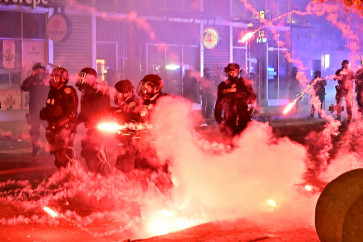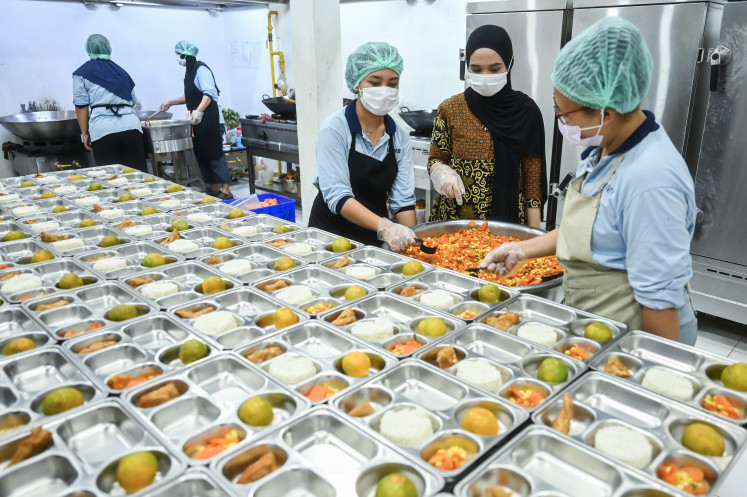Popular Reads
Top Results
Can't find what you're looking for?
View all search resultsPopular Reads
Top Results
Can't find what you're looking for?
View all search resultsA tranquil Waisak at Borobudur, despite hiccups
Majestic: Borobudur Temple is shrouded in dark clouds during the observation of Waisak on May 25
Change text size
Gift Premium Articles
to Anyone

M
span class="caption">Majestic: Borobudur Temple is shrouded in dark clouds during the observation of Waisak on May 25. The ceremony this year attracted more than 9,000 people.
'There's no point in celebrating Waisak if we are struck by the way it is celebrated, but do not truly acknowledge the real meaning of the Waisak celebration itself,' said Arief Harsono to the crowd at the opening of this year's ritual observations of the holiday at Borobudur Temple in Magelang, Central Java.
The message from one of the leaders of the Indonesian Buddhist Council (Walubi) should have resonated with the non-Buddhists and devoted Buddhists alike who stood under the rain of the night on May 25.
However, the way that both groups responded to Waisak, the day that marks Buddha's enlightenment, was different.
Fallout from the ceremony spread on social media over the next several days, with some saying that that non-Buddhist visitors to the temple had been uncivilized, improperly dressed and did not respect the devoted Buddhists who came to participate in the ritual.
As filmmaker Joko Anwar said on Twitter: 'May those who are going to celebrate Waisak at Borobudur next year no longer disturb the prayers.' The comment was reposted hundreds of times by his followers.
However, Citra Surya, the general secretary of Walubi, was unflappable. 'A slight discomfort may have arisen from the weather, but we take it as a boon. According to Buddha's teaching, water has always been a form of blessing,' he said over the telephone.
Citra then recalled the tale of how Buddha Gautama once used water to cure people in the city of Vesali.
No complaints had been received from the Buddhists observing the Waisak celebration at Borobudur Temple, Citra said, adding that he was glad that the massive crowd assembled for the holiday did not disperse, despite the hard rain.
Their perseverance implied a wealth of energy. 'Such splendid enthusiasm for a Waisak celebration will have a positive effect on the tourism side,' Citra said.
He said that the participation of non-Buddhists in Waisak celebrations has always been traditional. Local people were expected to mix with Buddhists, or could just watch the procession.

As part of its observance of Waisak, Walubi also reached out the local community in Magelang, offering free check-ups and treatment to residents, regardless of their religious beliefs. Approximately 250 specialist doctors and 400 nurses from the Army, Air Force, police and other government institutions treated almost 10,000 people.
The Buddhists also went into the larger community during the Pindapata ceremony, when monks walked along Jl. Pemuda Raya in Magelang, asking for alms. The ritual does not stress how much in alms is given, but on how people could reduce their greed by giving.
Meanwhile, there were those whose intentions were solely to attend the main ritual held on the evening of May 25 to witness the release of 1000 decorative lamps into the night sky.
Nouval Maulana, a backpacker from Depok, West Java, said that he skipped watching the procession from Mendut to Borobudur Temple just to see the lanterns.
'It is mainly the 1,000-lamp procession that brought us here,' he said while waiting for the main ritual to begin.
According to Putra Dirgantara, a representative of PT Taman Wisata Candi Borobudur Prambanan Ratu Boko, the number of participants at this year's Waisak observation was huge.
Figures from Walubi back Putra up. While in 2012, the 8,000 access cards were sufficient; this year, the 9,000 cards that Walubi ordered printed were exhausted by the morning of May 25.
When asked on the morning of the event if more cards would be printed, Rusid, the official in charge of distribution, said no. 'There are many people who were not able to get cards. But no, we are not printing anymore.'
Technically, the cards were supposed to checked at the temple's Manohara gate, which was the same entrance used by the Buddhists to enter after assembling at Mendut Temple.
The parade included a host of flag bearers, holy water, the Tripitaka holy book, the Dharma wheel and assorted relics along with pilgrims from eight councils under Walubi and members of the general public who just joined in.
'There were those who forced their way in, despite not having cards,' Putra said.
There were no seperate paths between the Manohara gate and Zone 1 of Borobudur, where the main altar was placed. Visitors and Waisak participants were mixed together. Meanwhile, guards did not check cards at the next gate either. Hence, those who did not participate in the Buddhist procession could gain access to the main altar by buying a general ticket to enter the Borobudur complex.
Inside Zone 1, there were no separate areas for Buddhists and non-Buddhists. Everyone was expected to secure seats as fast as they could.
After listening to welcoming remarks from the committee at around 9 pm, attendees were invited to stand up and permitted to stand up and participate in the Pradaksina ' the ritual of walking around Borobudur Temple three times to honor Buddha Gautama.
As the crowd moved forward, the rain fell harder, obliging attendees to open their umbrellas, if they had any. In the middle of the crowd, it was hard to see where the mass of people was moving, except forward.
As attendees strived to move closer to the main altar, a member of the crowd stooped and picked one of the chrysanthemum flowers placed in reverance in a decorative pot.
Others soon followed suit. Meanwhile, a few meters away, another attendee was heard mimicking ' and not in a flattering way ' the chants of the monks.
After several attempts, organizers managed to clear the area by the main altar and direct people to participate in the Pradaksina ritual.
The anticipated ceremony to release the lamps was canceled due to the rain that continued until midnight. Organizers offered participants refunds or the option to take away a lamp.
While some took to Twitter to complain, Putra said that that PT TWC only manages the temple site. 'There have been assumptions that we also hold responsibility for the ceremonial matters, while actually we were not expected to be directly involved.'
Meanwhile, Citra Surya said that Walubi did not usually crack down on crowd control on Waisak.
'It depends on the situation. Tight regulations are usually applied when we are expecting guests such as the president,' Citra said.
In response to those who took flowers or food from the altar, Citra said the committee actually did not mind. 'The offerings were meant to be distributed after the event anyway.'
' Photos By JP/ Klara Virencia









